Haoran Wei
additional authors not shown
DFR: A Decompose-Fuse-Reconstruct Framework for Multi-Modal Few-Shot Segmentation
Jul 22, 2025Abstract:This paper presents DFR (Decompose, Fuse and Reconstruct), a novel framework that addresses the fundamental challenge of effectively utilizing multi-modal guidance in few-shot segmentation (FSS). While existing approaches primarily rely on visual support samples or textual descriptions, their single or dual-modal paradigms limit exploitation of rich perceptual information available in real-world scenarios. To overcome this limitation, the proposed approach leverages the Segment Anything Model (SAM) to systematically integrate visual, textual, and audio modalities for enhanced semantic understanding. The DFR framework introduces three key innovations: 1) Multi-modal Decompose: a hierarchical decomposition scheme that extracts visual region proposals via SAM, expands textual semantics into fine-grained descriptors, and processes audio features for contextual enrichment; 2) Multi-modal Contrastive Fuse: a fusion strategy employing contrastive learning to maintain consistency across visual, textual, and audio modalities while enabling dynamic semantic interactions between foreground and background features; 3) Dual-path Reconstruct: an adaptive integration mechanism combining semantic guidance from tri-modal fused tokens with geometric cues from multi-modal location priors. Extensive experiments across visual, textual, and audio modalities under both synthetic and real settings demonstrate DFR's substantial performance improvements over state-of-the-art methods.
CMP: A Composable Meta Prompt for SAM-Based Cross-Domain Few-Shot Segmentation
Jul 22, 2025Abstract:Cross-Domain Few-Shot Segmentation (CD-FSS) remains challenging due to limited data and domain shifts. Recent foundation models like the Segment Anything Model (SAM) have shown remarkable zero-shot generalization capability in general segmentation tasks, making it a promising solution for few-shot scenarios. However, adapting SAM to CD-FSS faces two critical challenges: reliance on manual prompt and limited cross-domain ability. Therefore, we propose the Composable Meta-Prompt (CMP) framework that introduces three key modules: (i) the Reference Complement and Transformation (RCT) module for semantic expansion, (ii) the Composable Meta-Prompt Generation (CMPG) module for automated meta-prompt synthesis, and (iii) the Frequency-Aware Interaction (FAI) module for domain discrepancy mitigation. Evaluations across four cross-domain datasets demonstrate CMP's state-of-the-art performance, achieving 71.8\% and 74.5\% mIoU in 1-shot and 5-shot scenarios respectively.
Qwen3 Technical Report
May 14, 2025



Abstract:In this work, we present Qwen3, the latest version of the Qwen model family. Qwen3 comprises a series of large language models (LLMs) designed to advance performance, efficiency, and multilingual capabilities. The Qwen3 series includes models of both dense and Mixture-of-Expert (MoE) architectures, with parameter scales ranging from 0.6 to 235 billion. A key innovation in Qwen3 is the integration of thinking mode (for complex, multi-step reasoning) and non-thinking mode (for rapid, context-driven responses) into a unified framework. This eliminates the need to switch between different models--such as chat-optimized models (e.g., GPT-4o) and dedicated reasoning models (e.g., QwQ-32B)--and enables dynamic mode switching based on user queries or chat templates. Meanwhile, Qwen3 introduces a thinking budget mechanism, allowing users to allocate computational resources adaptively during inference, thereby balancing latency and performance based on task complexity. Moreover, by leveraging the knowledge from the flagship models, we significantly reduce the computational resources required to build smaller-scale models, while ensuring their highly competitive performance. Empirical evaluations demonstrate that Qwen3 achieves state-of-the-art results across diverse benchmarks, including tasks in code generation, mathematical reasoning, agent tasks, etc., competitive against larger MoE models and proprietary models. Compared to its predecessor Qwen2.5, Qwen3 expands multilingual support from 29 to 119 languages and dialects, enhancing global accessibility through improved cross-lingual understanding and generation capabilities. To facilitate reproducibility and community-driven research and development, all Qwen3 models are publicly accessible under Apache 2.0.
PolyMath: Evaluating Mathematical Reasoning in Multilingual Contexts
Apr 30, 2025Abstract:In this paper, we introduce PolyMath, a multilingual mathematical reasoning benchmark covering 18 languages and 4 easy-to-hard difficulty levels. Our benchmark ensures difficulty comprehensiveness, language diversity, and high-quality translation, making it a highly discriminative multilingual mathematical benchmark in the era of reasoning LLMs. We conduct a comprehensive evaluation for advanced LLMs and find that even Qwen-3-235B-A22B-Thinking and Gemini-2.5-pro, achieve only 54.6 and 52.2 benchmark scores, with about 40% accuracy under the highest level From a language perspective, our benchmark reveals several key challenges of LLMs in multilingual reasoning: (1) Reasoning performance varies widely across languages for current LLMs; (2) Input-output language consistency is low in reasoning LLMs and may be correlated with performance; (3) The thinking length differs significantly by language for current LLMs. Additionally, we demonstrate that controlling the output language in the instructions has the potential to affect reasoning performance, especially for some low-resource languages, suggesting a promising direction for improving multilingual capabilities in LLMs.
Enhancing LLM Language Adaption through Cross-lingual In-Context Pre-training
Apr 29, 2025Abstract:Large language models (LLMs) exhibit remarkable multilingual capabilities despite English-dominated pre-training, attributed to cross-lingual mechanisms during pre-training. Existing methods for enhancing cross-lingual transfer remain constrained by parallel resources, suffering from limited linguistic and domain coverage. We propose Cross-lingual In-context Pre-training (CrossIC-PT), a simple and scalable approach that enhances cross-lingual transfer by leveraging semantically related bilingual texts via simple next-word prediction. We construct CrossIC-PT samples by interleaving semantic-related bilingual Wikipedia documents into a single context window. To access window size constraints, we implement a systematic segmentation policy to split long bilingual document pairs into chunks while adjusting the sliding window mechanism to preserve contextual coherence. We further extend data availability through a semantic retrieval framework to construct CrossIC-PT samples from web-crawled corpus. Experimental results demonstrate that CrossIC-PT improves multilingual performance on three models (Llama-3.1-8B, Qwen2.5-7B, and Qwen2.5-1.5B) across six target languages, yielding performance gains of 3.79%, 3.99%, and 1.95%, respectively, with additional improvements after data augmentation.
Perception-R1: Pioneering Perception Policy with Reinforcement Learning
Apr 10, 2025Abstract:Inspired by the success of DeepSeek-R1, we explore the potential of rule-based reinforcement learning (RL) in MLLM post-training for perception policy learning. While promising, our initial experiments reveal that incorporating a thinking process through RL does not consistently lead to performance gains across all visual perception tasks. This leads us to delve into the essential role of RL in the context of visual perception. In this work, we return to the fundamentals and explore the effects of RL on different perception tasks. We observe that the perceptual complexity is a major factor in determining the effectiveness of RL. We also observe that reward design plays a crucial role in further approching the upper limit of model perception. To leverage these findings, we propose Perception-R1, a scalable RL framework using GRPO during MLLM post-training. With a standard Qwen2.5-VL-3B-Instruct, Perception-R1 achieves +4.2% on RefCOCO+, +17.9% on PixMo-Count, +4.2% on PageOCR, and notably, 31.9% AP on COCO2017 val for the first time, establishing a strong baseline for perception policy learning.
Perception in Reflection
Apr 09, 2025
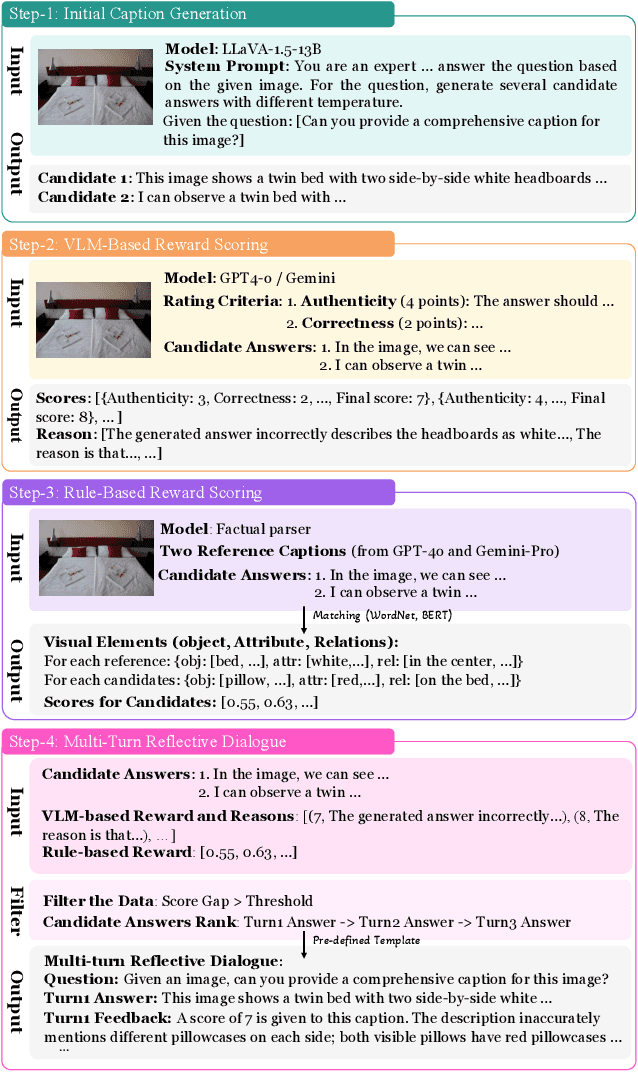
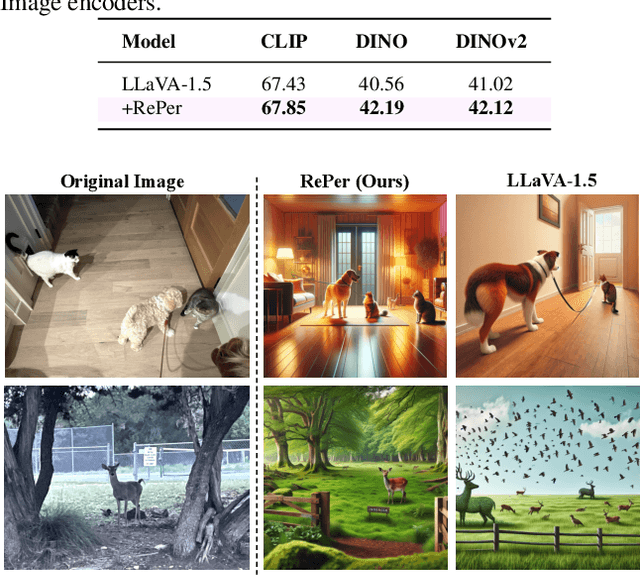
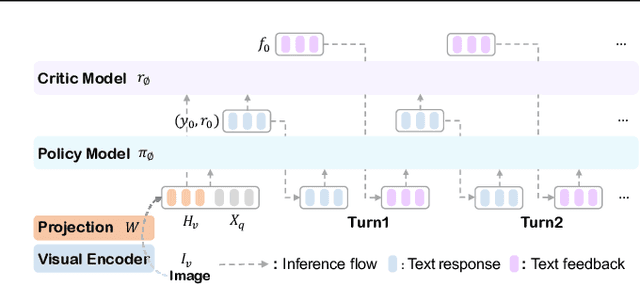
Abstract:We present a perception in reflection paradigm designed to transcend the limitations of current large vision-language models (LVLMs), which are expected yet often fail to achieve perfect perception initially. Specifically, we propose Reflective Perception (RePer), a dual-model reflection mechanism that systematically alternates between policy and critic models, enables iterative refinement of visual perception. This framework is powered by Reflective Perceptual Learning (RPL), which reinforces intrinsic reflective capabilities through a methodically constructed visual reflection dataset and reflective unlikelihood training. Comprehensive experimental evaluation demonstrates RePer's quantifiable improvements in image understanding, captioning precision, and hallucination reduction. Notably, RePer achieves strong alignment between model attention patterns and human visual focus, while RPL optimizes fine-grained and free-form preference alignment. These advancements establish perception in reflection as a robust paradigm for future multimodal agents, particularly in tasks requiring complex reasoning and multi-step manipulation.
CMaP-SAM: Contraction Mapping Prior for SAM-driven Few-shot Segmentation
Apr 07, 2025



Abstract:Few-shot segmentation (FSS) aims to segment new classes using few annotated images. While recent FSS methods have shown considerable improvements by leveraging Segment Anything Model (SAM), they face two critical limitations: insufficient utilization of structural correlations in query images, and significant information loss when converting continuous position priors to discrete point prompts. To address these challenges, we propose CMaP-SAM, a novel framework that introduces contraction mapping theory to optimize position priors for SAM-driven few-shot segmentation. CMaP-SAM consists of three key components: (1) a contraction mapping module that formulates position prior optimization as a Banach contraction mapping with convergence guarantees. This module iteratively refines position priors through pixel-wise structural similarity, generating a converged prior that preserves both semantic guidance from reference images and structural correlations in query images; (2) an adaptive distribution alignment module bridging continuous priors with SAM's binary mask prompt encoder; and (3) a foreground-background decoupled refinement architecture producing accurate final segmentation masks. Extensive experiments demonstrate CMaP-SAM's effectiveness, achieving state-of-the-art performance with 71.1 mIoU on PASCAL-$5^i$ and 56.1 on COCO-$20^i$ datasets.
MegaScale-Infer: Serving Mixture-of-Experts at Scale with Disaggregated Expert Parallelism
Apr 03, 2025



Abstract:Mixture-of-Experts (MoE) showcases tremendous potential to scale large language models (LLMs) with enhanced performance and reduced computational complexity. However, its sparsely activated architecture shifts feed-forward networks (FFNs) from being compute-intensive to memory-intensive during inference, leading to substantially lower GPU utilization and increased operational costs. We present MegaScale-Infer, an efficient and cost-effective system for serving large-scale MoE models. MegaScale-Infer disaggregates attention and FFN modules within each model layer, enabling independent scaling, tailored parallelism strategies, and heterogeneous deployment for both modules. To fully exploit disaggregation in the presence of MoE's sparsity, MegaScale-Infer introduces ping-pong pipeline parallelism, which partitions a request batch into micro-batches and shuttles them between attention and FFNs for inference. Combined with distinct model parallelism for each module, MegaScale-Infer effectively hides communication overhead and maximizes GPU utilization. To adapt to disaggregated attention and FFN modules and minimize data transmission overhead (e.g., token dispatch), MegaScale-Infer provides a high-performance M2N communication library that eliminates unnecessary GPU-to-CPU data copies, group initialization overhead, and GPU synchronization. Experimental results indicate that MegaScale-Infer achieves up to 1.90x higher per-GPU throughput than state-of-the-art solutions.
Unhackable Temporal Rewarding for Scalable Video MLLMs
Feb 17, 2025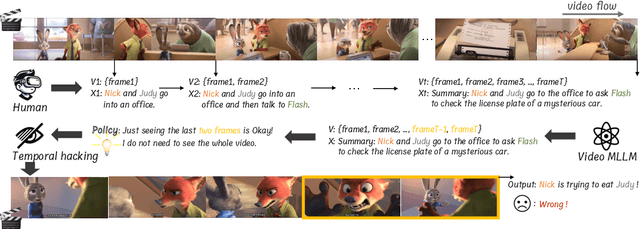

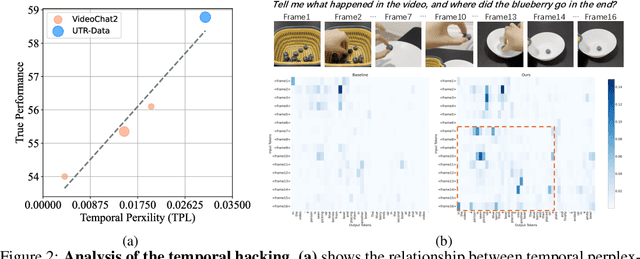

Abstract:In the pursuit of superior video-processing MLLMs, we have encountered a perplexing paradox: the "anti-scaling law", where more data and larger models lead to worse performance. This study unmasks the culprit: "temporal hacking", a phenomenon where models shortcut by fixating on select frames, missing the full video narrative. In this work, we systematically establish a comprehensive theory of temporal hacking, defining it from a reinforcement learning perspective, introducing the Temporal Perplexity (TPL) score to assess this misalignment, and proposing the Unhackable Temporal Rewarding (UTR) framework to mitigate the temporal hacking. Both theoretically and empirically, TPL proves to be a reliable indicator of temporal modeling quality, correlating strongly with frame activation patterns. Extensive experiments reveal that UTR not only counters temporal hacking but significantly elevates video comprehension capabilities. This work not only advances video-AI systems but also illuminates the critical importance of aligning proxy rewards with true objectives in MLLM development.
 Add to Chrome
Add to Chrome Add to Firefox
Add to Firefox Add to Edge
Add to Edge